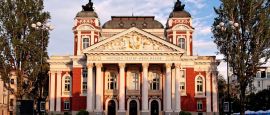Plovdiv lies in the heart of the Thracian Valley, the most important wine-producing region in Bulgaria. This makes Plovdiv an ideal base to explore wineries around this region. For more infomation, check out The complete guide to Bulgarian wine.
Bulgaria things to see and do
Tourist offices
Address: 1 Sveta Nedelya Square, Sofia, 1040, Bulgaria
Tel: +359 2 933 58 11.
Opening Hours:
Mon-Fri 0900-1700.
www.bulgariatravel.org
Discover Bulgaria's UNESCO-listed World Heritage Sites:
• Boyana Church, a medieval Bulgarian Orthodox church on the outskirts of Sofia.
• Madara Rider, a large rock relief depicting a knight triumphing over a lion in Madara.
• Rila Monastery, the largest and most famous Eastern Orthodox monastery in Bulgaria.
• Rock-hewn churches of Ivanovo, a series of chapels, churches and monasteries within the Rusenski Lom Nature Park.
• Thracian tomb of Kazanlak, a richly decorated burial chamber from the Hellenistic period.
• Thracian tomb of Sveshtari, an amazing historical site reflecting the fundamental structural principles of Thracian cult buildings.
Explore the age-old town of Belogradchik, nestled in the foothills of the Balkan Mountains in northwest Bulgaria, near the Serbian border. The main attractions include the medieval Belogradchik Fortress and the Belogradchik Rocks, a wondrous expanse of bizarrely shaped, colourful rock formations, named a Natural Landmark by the Bulgarian government. The local History Museum (www.muzeibelogradchik.com) is also a worthy diversion.
Bulgaria has over 370km (230 miles) of glorious coastline with sandy beaches. Busy resorts include Sunny Beach and Golden Sands, picturesque Albena, historical Nesebar, the cultural and historical city of Varna, and the Mediterranean ambience of port city Bourgas.
Get back to nature in one of the three Bulgaria's national parks:
• Rila National Park in southwest Bulgaria is the country's largest national park, home to rare plants and animal species including endemic Rila rhubarb.
• Pirin National Park, 90km (56 miles) south of Rila National Park has over 70 glacial lakes and diverse limestone rocks.
• Central Balkan National Park in the heart of Bulgaria is popular with hikers, horse riders and keen mountain bikers.
Bulgaria's second-largest city is divided by the Maritsa River. Built around seven hills, Plovdiv boasts spectacular ancient ruins. Must-see sights include the Ancient Theatre, the Roman Stadium, the Archaeological Complex Nebet Tepe and excellent museums housing many items of archaeological interest.
Be fascinated by the vast collection of murals, woodcarvings, old weapons and bibles written on parchment at Rila Monastery, 121km (75 miles) from Sofia. Fire has destroyed most of the early 10th-century architecture, and the present buildings date from the 19th century, with the exception of the 14th-century Khrelio's Tower.
Skiing in Bulgaria is considerably cheaper than other popular resorts in Western Europe. The best-developed ski resorts are Bansko, Borovets and Pamporovo.
Discover different architectural styles from Greek, Roman, Byzantine to Ottoman in Sofia. The capital of Bulgaria boasts a string of museums, monuments, churches, art galleries and opera houses. The stunning gold-leaf domed Alexander Nevski Cathedral is the most famous sight. Visit the Sofia travel guide for more information.
For centuries Bulgarians have planted roses in an area known as the Rose Valley (a narrow band in the centre of the country), and extracted their heavenly essence - attar of roses. The Rose Valley is magically transformed with breathtaking blooms in May and early June each year when The Festival of Roses is celebrated in many towns of the region.
Spectacular Trigrad Gorge is in the Rhodope Mountains close to the town of Trigrad in Southern Bulgaria, and is flanked by vertical marble rocks rising to 300m (980ft). It is a popular place for hiking, biking, birdwatching and fishing. The Devil’s Throat Cave is a popular tourist destination with water from the Trigrad River feeding huge waterfalls down its 'throat', before cascading 42m (138ft) down into the abyss below. Nearby is the famous Haramiiska Cave where archaeologists discovered evidence of human habitation dating back over 4,000 years.
A major seaside resort on the Bulgarian Black Sea Coast, Varna attracts sun worshippers and also cultural buffs. The magnificent Roman baths in Varna are a relic of Roman legacy in Bulgaria. Visit the well-preserved baths, the largest Roman public building in Bulgaria, and then wander through the seaside city of Varna for sweeping views of the Black Sea and endless historical landmarks.
Visit the ancient museum town of Veliko Tarnovo, capital of the Second Bulgarian Empire (1185-1396), situated on three hills circled by the River Yantra. It contains extraordinary collections of historical works of art, including church relics.
Do you have any Feedback about this page?
© 2025 Columbus Travel Media Ltd. All rights reserved. No part of this site may be reproduced without our written permission, click here for information on Columbus Content Solutions.








 You know where
You know where